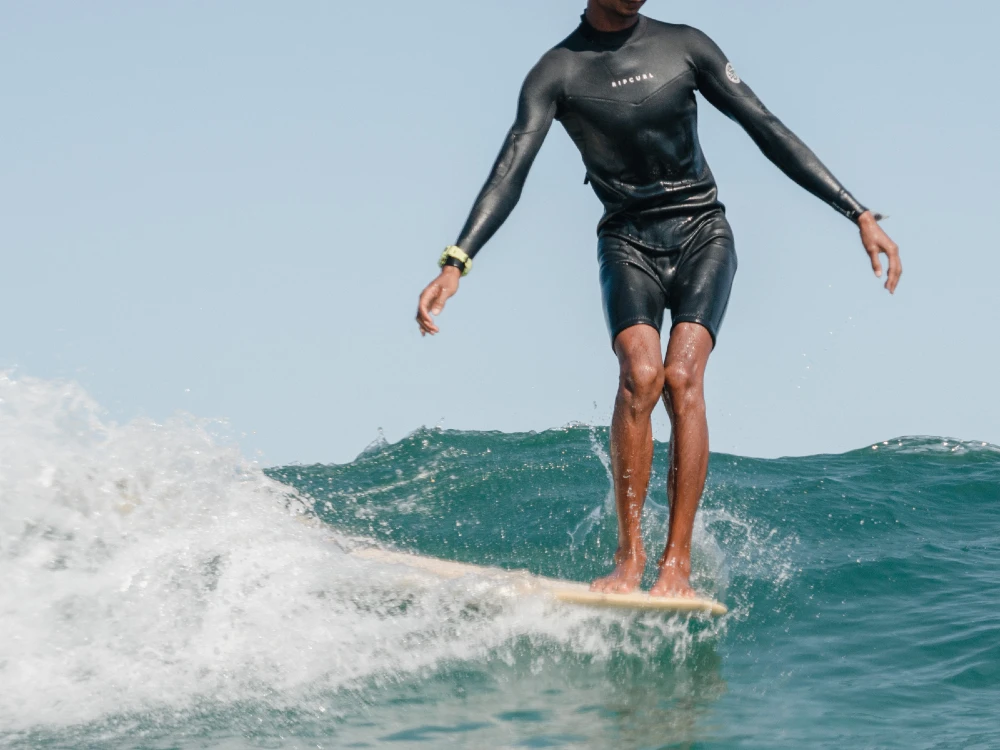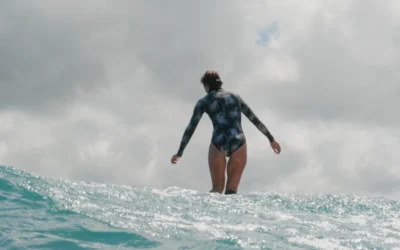We look back to the past for two reasons: to reminisce about the good times and to learn from our mistakes.
Looking back at the history of longboarding, however, is more about enriching the present. Longboarding has and always will be full of colourful characters, daring innovations, canny adventurers and unforgettable moments. Isn’t it time we celebrated the pastime we know and love?
Whether you’ve longboarded your whole life or you’re just now taking it up, learning about its history gives us a deeper appreciation for the sport and its evolution.
Let’s get started.


12th Century / The birth of “longboard” surfing
The birth of surfing could also be called the birth of longboarding.
It all started in the 12th century when Polynesian islanders began riding waves on solid wood planks, using their bodies as paddles to catch and ride the swells.
These early “longboards” were typically around 12-18 feet in length and provided a way for islanders to travel between islands. They also held a significant cultural and spiritual importance in Polynesian society.
→ Here’s how longboarding differs from other types of surfing
Early 1900s / Longboard surfing comes to the USA
Fast forward to the 20th century and surfing was already a major pastime in Hawaii.
But it wasn’t until the early 1900s that longboard surfing made its way to the United States, specifically California. In 1907, a local Hawaiian by the name of George Freeth brought his longboard to Redondo Beach.
Longboards during this time were heavy, awkward and difficult to manoeuvre. This didn’t stop curious beachgoers from enquiring about this new form of riding waves.
Eventually, longboard surfing began to gain recognition and popularity in California before spreading further afield.
1914 / Australia learns of longboard surfing?
Duke Kahanamoku, a well-known Hawaiian surfer and Olympic swimmer, introduced longboard surfing to Australia in 1914.
He performed an exhibition of the sport at Freshwater Beach in Sydney, leaving Australians inspired and intrigued by this unique way of catching waves. Australia was quick to adopt longboard surfing and it became a part of the country’s beach culture.
Despite this, rumours swirled around Australia that a merchant seamen by the name of Tommy Walker was surfing in Manly at least six summers earlier than the Duke.
Photographic evidence has been circulated, but nobody knows for sure if Walker was the first to surf Australia’s waves on a longboard or if the Duke holds that accolade.
1930s / Hollow longboard surfboards
Up until this point, longboard surfboards were still made of solid wood and could weigh up to 150 pounds (70 kg).
With the creation of hollow boards, surfing became more accessible to a wider audience, as it was no longer necessary to have specialised knowledge or skills in order to transport the heavy boards.
American athlete Tom Blake ushered in a new era of surfing by shaping the first ever hollow surfboard.
In addition to being lighter and easier to carry, hollow boards were also more buoyant and easier to manoeuvre on the waves, opening up possibilities for new surfing manoeuvres and tricks.
→ Learn how to buy your first longboard surfboard
1947 / Rabbit Kekai wows Joe Quigg
The end of WWII saw thousands of surfers return to American soil after swapping childhood stories about their exploits in California and Hawaii while in the service.
One of these returning surfers was Joe Quigg, a San Diego local who would go on to become a prolific board designer and surfer. Flying straight to Waikiki, Joe was one of the lucky few who arrived in Hawaii just when Rabbit Kekai, a local standout, was tearing up the waves.
Quigg and his fellow Californian surfers were able to witness Kekai’s unique and innovative approach to surfing firsthand.
This encounter would have a lasting impact on Quigg and his peers, shaping their own surfing styles and leading them down the path of board design experimentation.
1950 / Darrylin Zanuck and the precursor to the modern longboard
While the history of longboarding is often cited as a strictly male affair, the modern longboard wouldn’t exist without an unassuming 17-year-old girl by the name of Darrylin Zanuck.
Darrylin was the girlfriend of Tommy Zahn, Joe Quigg’s best friend. And when Quigg was asked to make her a board in the summer of 1948, little did he know that this request would lead to a major design breakthrough for surfing.
The Darrylin board was not only lightweight and easy to carry, but it also had a shorter length which made it perfect for fitting into her convertible car.
However, when Quigg’s friends saw the board, they all wanted a go on it. And with its amazing looseness and performance, the Darrylin board quickly became popular among Quigg’s crew.
So popular, in fact, that when Tommy and Darrylin broke up the following year, Tommy tried to keep the board for himself. This led to a break-in by Darrylin in order to reclaim her beloved board.
Many people say that the “Darrylin” board paved the way for the modern longboard.
Late 1950s / Aggressive manoeuvres, shorter boards
With shorter, more agile boards now in the mix, surfers began experimenting with more aggressive manoeuvres and riding styles.
The late 1950s saw the emergence of surfers like Miki Dora and Phil Edwards, who were known for their smooth and stylish surfing techniques.
The drop-knee cutback and the noseride became popular moves during this time, as surfers pushed the limits of what was possible on the waves.
Gone were the days of clunky, heavy boards. The 1950s marked a turning point in the evolution of surfing, as surfers began to truly embody the sport’s spirit of freedom and creativity (and even lawlessness in the case of Da Cat).
→ 21 frequently asked questions about longboarding Lombok
1960s / Shortboarding versus longboard surfing
With longboards getting progressively shorter, the stage was set for a new surfing revolution in the 1960s.
Australian surfers like Nat Young and Bob McTavish began experimenting with even shorter boards, leading to the creation of the “shortboard”.
This new style of surfing placed more emphasis on quick turns and manoeuvres, rather than just riding straight along the wave. For the first time in surfing history a line was drawn. Surfers now either fell into the “longboarder” or the “shortboarder” category.
This era also saw the emergence of surf culture and lifestyle, with films like The Endless Summer introducing surfing to a wider audience.
Surfing became more than just a sport – it became a way of life.
1970s / The ASP Longboarding World Tour
Funnily enough, the people who split the surfing world in two suddenly become pivotal figures in the first longboard renaissance.
Nat “The Animal” Young in particular was instrumental in reviving interest and participation in longboarding, both as a competitor and through his involvement with the ASP Longboarding World Tour.
His skill, experience, and passion for the sport helped to shape the judging criteria and push for a balance between traditional and progressive styles of surfing.
He also became the most dominant longboarder on the tour, winning year-on-year throughout the 80s (barring ’87).
1990s / High-performance longboarding
High performance longboard surfing took hold in the 90s.
Surfers rode the boards off the tail and executed progressive manoeuvres, which were impressive but often lacked the traditional values of style and grace.
This was the wedge within the wedge of longboarding, with high-performance surfers in one camp and traditionalists in the other. But as the decade came to a close, it became evident that there was room for both styles to coexist in the world of longboard surfing.
Thomas Campbell, an artist and filmmaker, released The Seedling in 1999 which sparked a resurgence of traditional longboarding around the globe.
The film glorified the classic style of logging and left many modern high-performance surfers turning to traditional longboarding for inspiration.
→ 15 Lombok longboarding and travel tips
2000s to now / Joel Tudor, the Duct Tape Invitational and the return to traditional longboarding
Joel Tudor is a polarising personality in surfing, but one thing is undeniable – his impact on the sport and the world of traditional longboarding.
Brought up under the tutelage of Nat Young and radical longboarder Donald Takayama, Tudor’s style is a melting pot of old and new.
His graceful, traditional approach to longboarding has earned him numerous titles and accolades, but it was his creation of the Duct Tape Invitational in 2010 that truly put him on the map as a pioneer of traditional longboarding.
The Duct Tape Invitational is an invitation-only surfing contest that brings together some of the best longboarders from around the globe to showcase their skills on classic single fin boards.
The event has become synonymous with style, grace and creativity, reviving interest in traditional longboarding and inspiring a new generation of surfers to embrace its roots.
Final Thoughts
Today, longboarding continues to evolve and incorporate different styles and techniques while staying true to its origins. And here at Xanadu, we like to think there’s room for everyone partial to 9 foot plus surfboards.
With regular longboard weeks, an almost unfair number of epic longboarding surf spots and in-depth local knowledge that practically guarantees you score perfect waves, we take longboarding seriously (well… kinda seriously).




